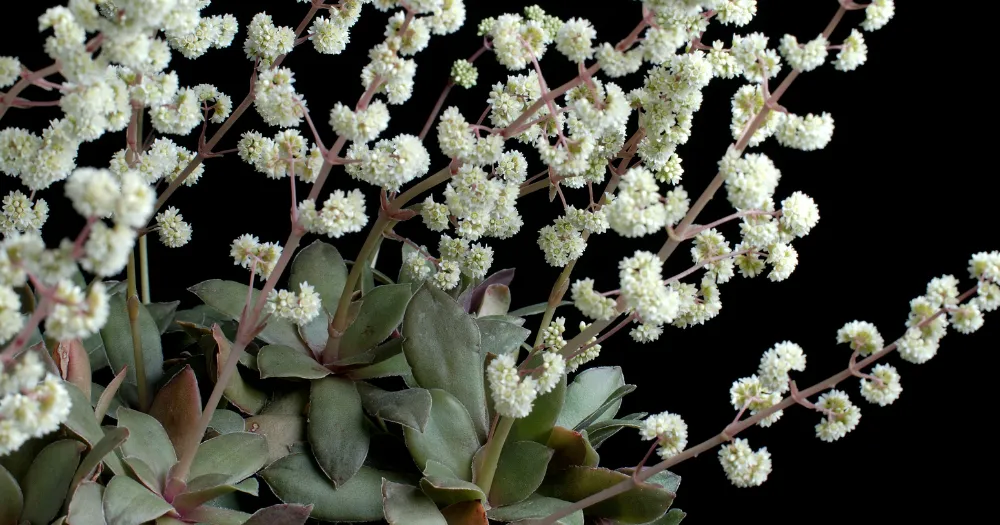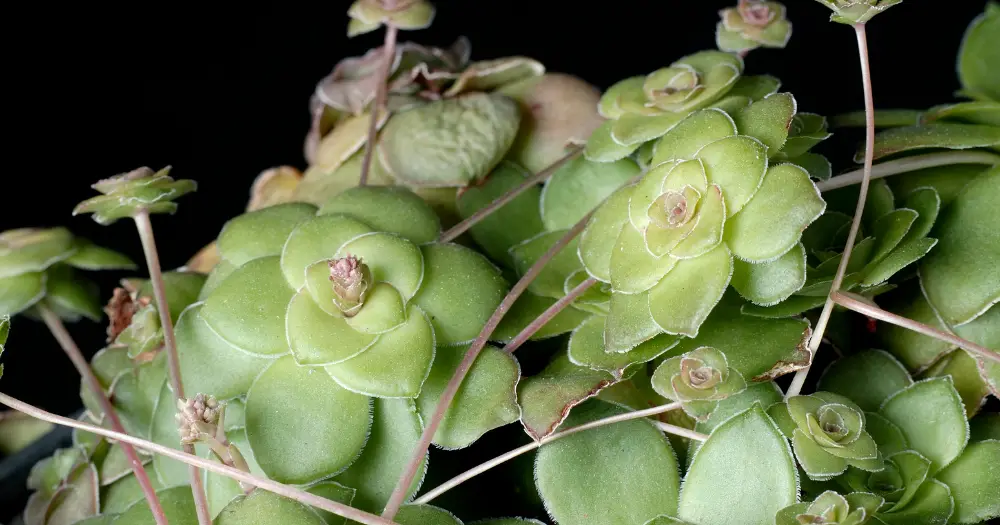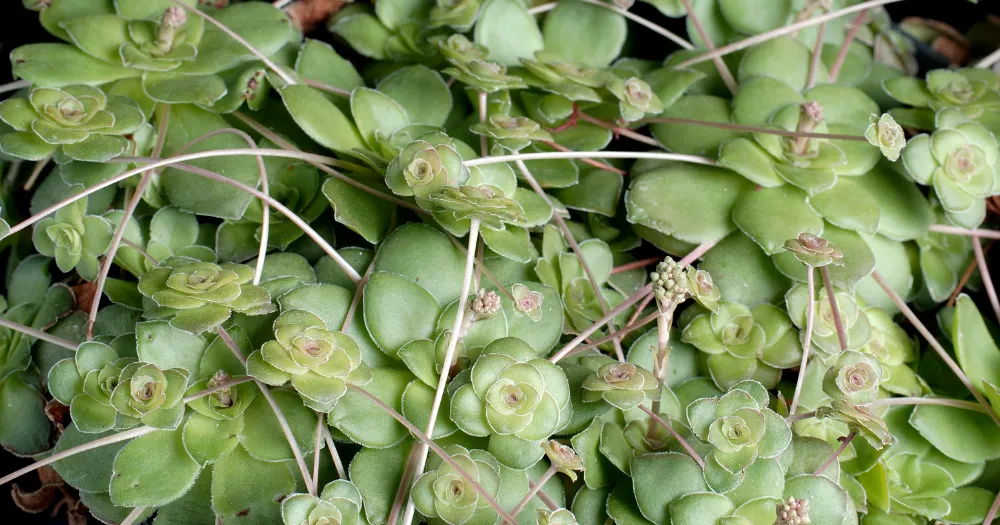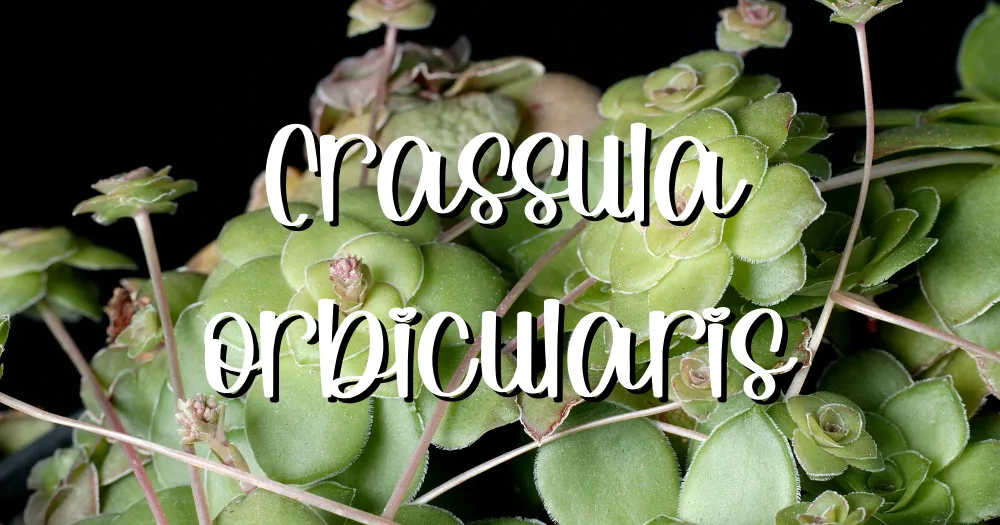Crassula orbicularis is a small succulent with round, blue-green leaves arranged in a rosette pattern. The leaves have a slight curvature and are covered with a powdery white coating that gives them a unique and distinctive appearance. This succulent can grow up to 3 inches in height and 6 inches in width, making it a perfect choice for small indoor spaces. It is also known as the ‘Roundleaf Stonecrop’, ‘Copper Coins’, or ‘Button Plant’.
| Common Name | Crassula Orbicularis |
| Latin Name | Crassula orbicularis |
| Native Habitat | South Africa |
| Hardiness Zone | 10b to 11b |
| Temperature Range | 50°F to 80°F |
| Poisonous? | Non-Toxic to humans and pets |

Native Habitat
Crassula orbicularis is native to South Africa. In its natural habitat, it grows in rocky areas, within crevices in rock formations, and on cliffs. This succulent thrives in hot and dry conditions with little rainfall. It is well adapted to survive drought-like conditions with minimal water. Crassula orbicularis can tolerate full sun exposure, but it also grows well in partial shade. Its ability to thrive in a range of light conditions and its drought tolerance make it a popular houseplant that can do well with relatively minimal care. However, it does require fast-draining soil to avoid root rot. Its native habitat of rocky cliffs and crevices indicates that it evolved to thrive in sandy, well-draining soil.
You might also like: 5 Essential Mental Health Benefits of Gardening Succulents and Cacti
How to Water & Fertilize
Water Crassula orbicularis when the soil is completely dry, usually every 7-10 days. It’s essential to use a well-draining soil mix, such as a combination of Turface, pumice, perlite, and coarse sand, to prevent root rot. During the growing season, fertilize once a month with a succulent fertilizer diluted to half strength.
Crassula orbicularis is a succulent plant, which means that it stores water in its leaves. This allows it to thrive with less frequent watering than most other plants. In fact, overwatering can lead to root rot and kill Crassula orbicularis. The best practice is to wait until the soil is completely dry before watering this succulent again. You can check the soil dryness by sticking your finger in the pot. If the soil feels dry to the touch, it is time to water.
When watering Crassula orbicularis, use a well-draining soil mix. This aids in preventing the roots from sitting in water, which can cause root rot. Fertilize this succulent once a month during the growing season with a balanced fertilizer diluted to half strength. As succulents are sensitive to fertilizers, use a diluted solution.
Additional tips for caring for Crassula orbicularis:
• Water deeply until water reaches the roots.
• Fertilize during spring and summer when actively growing. Avoid fertilizing during fall and winter dormancy.
• Place in a sunny spot indoors near a window or outdoors in full sun.
• Crassula orbicularis cannot tolerate cold winters. Grow in appropriate hardiness zones.
With fast-draining soil, appropriate watering, fertilizing, and lighting conditions, Crassula orbicularis can thrive as a houseplant or in outdoor gardens in suitable climates. However, it is sensitive to overwatering and cold temperatures, so care must be taken to meet its needs for a healthy, long-lived succulent.
You might also like: 5 Reasons to Avoid Misting Succulents: The Surprising Consequences of Misting or Succulent Fertilizer: The Ultimate Guide to Healthy Succulents + 8 DIY Fertilizer Recipes

Soil
Crassula orbicularis prefers well-draining soil that allows air to circulate around the roots. A good soil mix for this succulent is one that contains equal parts of Turface, pumice, perlite, and coarse sand. These soil amendments will help improve drainage, prevent root rot, and provide essential nutrients to the plant.
Crassula orbicularis prefers sandy, well-draining soil with a slightly acidic pH between 6.5 and 7.5. The soil should contain rich organic matter yet not retain too much moisture. A loose, free-draining soil mix is ideal for this succulent. A suitable potting mix can be purchased or homemade using equal parts sand, perlite, pumice, and compost.
When planting, dig a hole twice the width of the root ball and amend the soil with compost. Backfill the hole with the soil mix and plant at the same depth as the pot. Water thoroughly and mulch to retain moisture.
To ensure healthy growth, water Crassula orbicularis when the soil is completely dry. Fertilize monthly during active growth and provide plenty of sunlight. Protect from frost. With proper soil conditions, watering, fertilizing, lighting, and temperature requirements met, Crassula orbicularis can thrive and provide many years of enjoyment.
You might also like: How to Grow Succulents Indoors Without Killing Them
How to Propagate Crassula orbicularis
To propagate Crassula orbicularis, follow these steps:
- Take a 2-4 inch stem or leaf cutting from a healthy, actively growing plant. Use sharp pruners or a knife and allow the cutting to dry for several days.
- Prepare a well-draining soil mix of equal parts sand, perlite, and compost.
- Plant the dried cutting in the soil mix and keep moist but not wet.
- Place in a bright spot out of direct sunlight. It can take several weeks for roots to form.
- Once rooted, transplant the new succulent to a larger pot.
Additional tips:
• Use a sharp knife or pruners to get a clean cut.
• Allow cuttings to dry for at least 24 hours to callus.
• Plant in suitable soil mix and maintain even moisture.
• Place in bright indirect light.
• Rooting can take weeks; transplant once rooted.
With the proper steps followed, Crassula orbicularis can be propagated through stem or leaf cuttings to produce new succulent plants. After caring for the cuttings during rooting, new healthy plants can be transplanted for display or sharing.
You might also like: Succulent Dormancy: 4 Easy Ways to Tell if Your Succulent is Going Dormant

Light
Crassula orbicularis stores water in its leaves and does not need as much light as other plants to survive. However, it does require sufficient light to photosynthesize and produce its own food. This succulent thrives in bright indirect light such as that filtered through trees or curtains or from skylights and windows not facing south. It can tolerate full sun if acclimated gradually to prevent leaf burn. Move the plant to brighter light in increments over weeks.
If grown indoors, place near a sunny window or under grow lights for 8-10 hours daily. Use a grow light designed for succulents if necessary. Adequate light is important to prevent leggy, elongated growth and dropped leaves.
Outdoors, site in full sun in hot, dry climates. With proper lighting, Crassula orbicularis can thrive as a houseplant or in gardens. Monitor for signs of too little or too much light and adjust conditions as needed for a healthy succulent.
You might also like: How Much Light Do Succulents Need? A Comprehensive Guide in 12 Parts
Hardiness Zone & Temperature
Crassula orbicularis is hardy in USDA zones 9a-11b, meaning it can tolerate temperatures as low as 20°F (-6°C). However, it prefers warm temperatures between 60-80°F (15-26°C). It’s essential to protect the plant from frost and freeze events by bringing it indoors or covering it with a frost cloth.
You might also like: Succulent Care by Zones
Common Problems & Solutions
One common problem with Crassula orbicularis is overwatering, which can lead to root rot. To prevent this, ensure the soil is well-draining and only water when the soil is completely dry. Another issue is leaf drop, which can be caused by a lack of sunlight or underwatering. To solve this, provide more light and water when the soil is dry.
Is it Poisonous? Crassula orbicularis is not poisonous to humans or pets, making it a safe choice for indoor or outdoor spaces.
You might also like: Are Succulents Poisonous to Dogs?

Where to Buy Succulents Online




